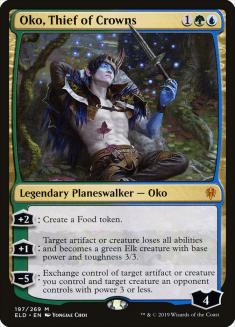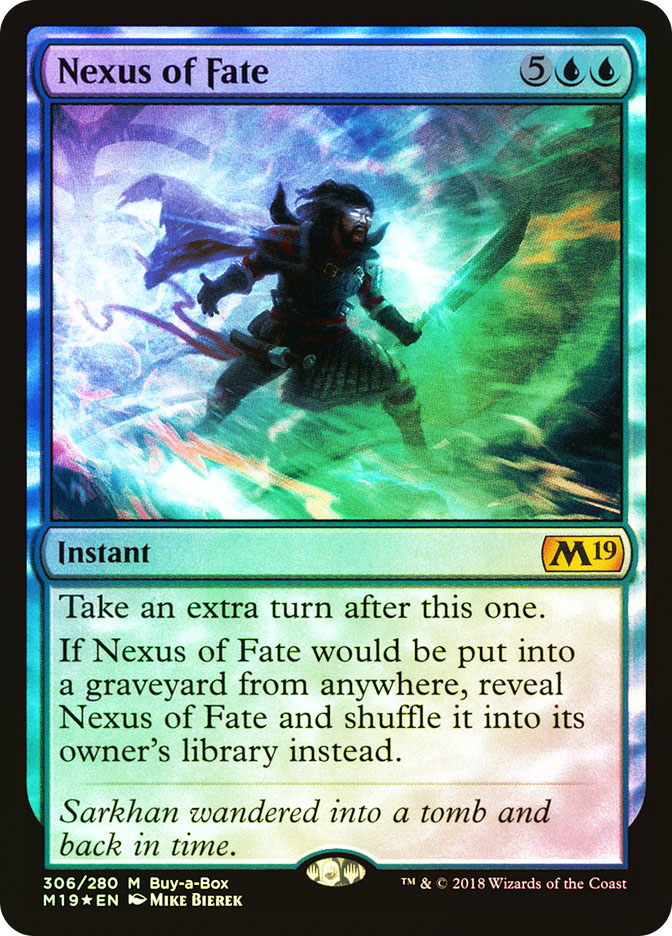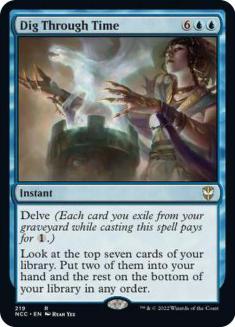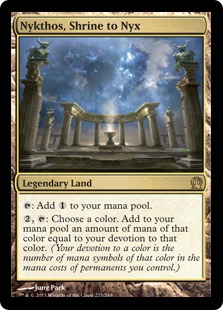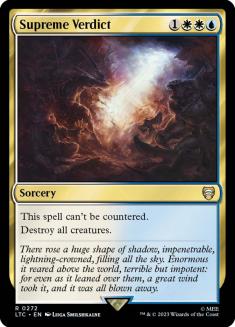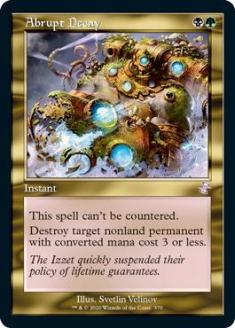Pioneer is in an interesting spot right now. The aggressive attitude towards banning cards that Wizards of the Coast (WotC) is using in the opening stage of the format has essentially hit reset on the metagame twice, first with the removal of Oath of Nissa, Leyline of Abundance, and Felidar Guardian, and later with the banning of Smuggler’s Copter, Field of the Dead, and Once Upon a Time.
However, the first ban was when the format was still in its absolute infancy, and there wasn’t really an established metagame beyond Mono-Green Devotion and various takes on Copy Cat, both of which were obviously overpowered. The second ban occurred far enough into the format’s development where we had an established tier of archetypes, with Mono-Black Aggro, green decks utilizing mana creatures and Once Upon a Time, and various Field of the Dead decks at the top, but a healthy range of fringe archetypes beneath it, from Simic Nexus to Azorius Control to Izzet Ensoul.
At this point we’ve learned some things about Pioneer. For instance, most control decks are base-Azorius because Supreme Verdict is irreplaceable in any other colors. Some formerly powerful cards like Deathrite Shaman and Emrakul, the Promised End have underperformed, while others, like Dig Through Time and Thoughtseize, have become format staples. Energy decks have largely been pushed out by similar archetypes utilizing the Food mechanic instead, though sometimes Rogue Refiner and Harnessed Lightning stick around because they are fine on their own.
After the first ban, we were largely doing the same things that we were before, brewing up anything that sounded sweet, throwing it all to the wall, and seeing what stuck. After the second major ban, we can ask ourselves which decks are winners and which decks are losers, and react accordingly.
The major implication of this is that I think any other broken cards will be found rather quickly, since there’s an established metagame to exploit, or at least there will be an established metagame quite quickly. We have a couple of PTQ results from last weekend to set the stage moving forward, and nothing looks particularly dominant.
Personally, I wouldn’t expect more than a couple more cards to be banned before we see a stable Pioneer, ready for the long haul, and it appears that the people at WotC agree with me, since they included the following paragraph at the end of the December 2nd Banned Announcement:

Maybe they’re just tired of the lunch jokes on Twitter every Monday, or the WotC expense account is getting low at the end of the year, but this paragraph was a clear signal to me that they think Pioneer is ready to exit its beta testing stage shortly, which is great news for those of you who have been hesitant to invest, only to see their deck be banned into irrelevance in a matter of weeks, if not days. The time is now to jump in the pool with the rest of us cool kids and enjoy Magic’s newest, and right now best, format.
But…(there’s always a but) there are still a few landmines to avoid. Based on my experience playing Pioneer over the last several weeks, and the results after the most recent bans, here is my list of cards that are, or should be, on the Watch List for banning in Pioneer:
Oko, Thief of Crowns
Oko is brokeo has been the cry of the masses since even before it was released, when word of the card’s power spread like wildfire among those playing the early access event on Arena. Since then, we’ve seen the card banned in Standard, come to dominate Modern, and make a significant impact in both Legacy and Vintage. It would be the height of naivete to think that Oko wouldn’t also make its presence known in Pioneer.
That said, the card hasn’t been an outsized part of the metagame in the opening weeks. It was a key part of the Copy Cat decks, offering the deck a great backup plan almost by itself, but without the false tempo of the combo the deck fell off. Later, Oko popped up in the Simic Aggro decks, but it wasn’t a key component. Those decks are looking to beat down with big creatures like Lovestruck Beast and Steel Leaf Champion, and they did so very reliably with Once Upon a Time.
It looked as though Pioneer was a little too aggressive, even for a three-mana planeswalker that ticks up to six loyalty. Older non-rotating formats have better cheap removal like Path to Exile and Lightning Bolt and/or better cheap counterspells like Daze and Force of Will, that help to blunt aggressive strategies, but Pioneer lags behind Modern and Legacy on that front, which helped those of us who like to get in the red zone early and often. And as always, early creatures will be the best way to check planeswalkers.
So why is Oko the first card on my Pioneer watch list? Because aggressive strategies took a hit during the last ban. Losing Once Upon a Time makes the Llanowar Elves / Elvish Mystic decks less consistent, and Smuggler’s Copter is an irreplaceable effect for Mono-Black Aggro, Izzet Ensoul, and Azorius Flash among others. That doesn’t mean these decks are going to disappear, but they will be significantly weaker, and that means the format slows down.
Then you have the removal of Field of the Dead, which largely checked midrange and control decks, keeping them from playing too reactive of a strategy, since Field of the Dead dominated the long game nearly every time. These decks are now free to be more removal heavy to strengthen their aggro matchups.
It doesn’t take much of a slowdown for Oko to start dominating, and we already saw signs of it last weekend, where the Simic Devotion deck Gerry Thompson advocated last week won one of the PTQs in the hands of yamakiller and took another Top 8 slot in the hands of Emma Handy.
This deck may be called Simic Devotion, but without Burning-Tree Emissary, it’s not the same synergy-driven deck that Todd Anderson has been cleaning up with since the format began. This is more akin to the Simic Food decks that took over Standard, but with Nykthos, Shrine to Nyx as a fine addition for a manabase that has enough early green sources and might as well get more value from its manabase.
The early success from this deck suggests the format has slowed down to a point where Oko is a good build-around, at which point all the available evidence says that it becomes dominant. Straight Simic may not be the best shell, but it’s Oko Autumn and WotC may not want to stick around for Oko Winter.
Nexus of Fate
Oh, Nexus of Fate. Loved by many, reviled by even more, it’s one of the most divisive cards in recent memory. Personally, I’m willing to forgive the annoying play pattern on the final combo turn because I think the gameplay leading to that turn is quite interesting and Nexus of Fate decks offer a check on reactive strategies that is much easier to interact with than Field of the Dead.
What I’m not willing to forgive is having the card only available in foil. No card that is legal for competitive play should only be printed in foil. Even if you don’t expect the card to show up much, it’s just not worth the risk. Nexus of Fate is the biggest punisher case, being a card that shuffles back into your deck during a loop where you want to draw it repeatedly, but it never should’ve gotten there. Who lets these things happen?!
Unfortunately, my abhorrence of foils isn’t enough to get them banned. Nexus of Fate, however, is one of the major beneficiaries of the recent bans, since the Simic Nexus deck doesn’t get touched and just like Oko, the aggressive decks that are Nexus’s biggest predators took a major hit. With enough time, Nexus of Fate decks can overcome plenty of disruption, whether Thoughtseize; Negate; Teferi, Time Raveler; or any combination thereof. But once that disruption comes paired with a clock, things get dicey. So even if the format slowdown comes with additional disruption in the metagame at large, Simic Nexus players will gladly take the trade.
Dig Through Time
While Nexus of Fate only fits into the one style of deck, Dig Through Time is on the chopping block because of how ubiquitous it may become. It’s a key component of Simic Nexus, giving the deck an incredibly efficient source of card advantage and card selection, but that’s something that combo and control decks of all stripes are looking for, and there doesn’t seem to be any better card for the job than Dig Through Time.
You find it in Lotus Field decks, Jeskai Ascendancy decks, and every blue control deck, even those that can cast Sphinx’s Revelation. It’s strange that Dig is showing up so much more often than Treasure Cruise, but not altogether unsurprising, given how Dig Through Time works much better in reactive shells since it’s an instant and can look further into your deck for specific answers, and that the combo decks in this format are all looking for very specific pieces. Even Jeskai Ascendancy, which in Standard utilized Treasure Cruise, uses Dig in Pioneer because it needs to find its Sylvan Caryatids and Sylvan Awakenings to pair with its namesake card.
I’m not confident any of the decks with Dig Through Time will rise to the level of oppressive, but WotC always takes notice when a card becomes too prevalent in a wide range of decks, and on that metric Dig Through Time could cross a line.
The good news is that a ban on Dig will not invalidate any of the decks it’s in, except perhaps Simic Nexus, so you shouldn’t be worried about investing in your Azorius Control deck and losing one of your better card advantage spells.
Nykthos, Shrine to Nyx
Gun to my head I’d say this card is safe for now, but the operative words there are for now. It has contributed to multiple other cards being banned and still sees significant play in the format and it’s only going to get better as the format grows. Our impending return to Theros has brought rampant speculation that it will see a reprint, but even failing that it will certainly get some fancy new toys to play with, and that’s dangerous.
The mana system is the backbone of Magic. And unsurprisingly, a huge number of Magic’s most powerful cards (Black Lotus, Sol Ring, various Moxen, Mishra’s Workshop) are those which break the rules of that system. Nykthos takes some set up and requires significant cost in deckbuilding, but the payoff is there, and we’ve seen it in action back in the Leyline of Abundance days. Generating such a huge mana advantage is overwhelming as there’s no shortage of powerful cards to sink that mana into, whether Voracious Hydra, Walking Ballista, Hydroid Krasis, or something else.
The only question here is when we get another set of enablers that push a devotion strategy over the top. It may not happen with Theros: Beyond Death, but Nykthos is living on borrowed time.
I don’t expect all four of these cards to be banned in the coming weeks, but two or three of them rounding out the initial Banned List before Pioneer syncs up with the rest of Magic’s formats wouldn’t surprise me. It may seem like WotC is simply banning away the top decks at each iteration, but the cards that are being banned are unique in what they do (Leyline of Abundance, Field of the Dead) or at least uniquely powerful in what they do (Smuggler’s Copter, Once Upon a Time), and thus they overshadow the other examples of that effect which exist in Pioneer.
You could say the same thing about the most popular removal spells, like Supreme Verdict, Abrupt Decay, and Thoughtseize, but the Banned List is always going to be more focused on powerful threats than powerful answers, since the threats are much more likely to warp the metagame. No matter how powerful answers are, there are threats that get around them. Fatal Push can’t answer Glorybringer, and Supreme Verdict doesn’t answer noncreature permanents.
As a result, these powerful answers are never going to push out other answers from the metagame, since they need to be supplemented by the answers that fill in the gaps that they miss. Threats that either end the game quickly if left unanswered or generate immediate value can still be played even in metagames that are filled with appropriate answers, while the converse is not true. Keep this in mind before you advocate for or expect a popular answer to be banned.
We all knew that some cards would be banned during this trial period in Pioneer. It’s unrealistic to think that a format which didn’t exist while these cards were designed would turn out completely balanced. But this methodology, starting small and aggressively adding cards in the early weeks, has played out much better than their strategy for Modern, starting big and paring down from there. Players want to have fun with their toys, even for a brief time, and years later we still likely haven’t unbanned everything we can from the initial Modern Banned List. By the end of this month, I expect Pioneer to have a minimally-constructed Banned List that makes sense, and that’s all we can ask for.

